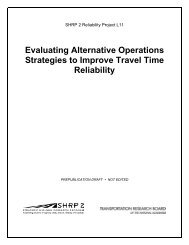Contemporary Approaches to Parking Pricing: - FHWA Operations
Contemporary Approaches to Parking Pricing: - FHWA Operations
Contemporary Approaches to Parking Pricing: - FHWA Operations
You also want an ePaper? Increase the reach of your titles
YUMPU automatically turns print PDFs into web optimized ePapers that Google loves.
Public Acceptance<br />
6.0<br />
Innovative parking pricing policies that do not gain political or public support either will not be enacted or will be<br />
quickly repealed. Taking the time <strong>to</strong> develop and implement an effective communication strategy, outreach plan,<br />
and, potentially, marketing plan, will go far <strong>to</strong>ward advancing program goals and reducing the stress placed upon<br />
parking managers and planners. Inadequate outreach efforts may lead elected officials and parking managers <strong>to</strong> be<br />
blindsided by public opposition and leave them unable <strong>to</strong> respond adequately <strong>to</strong> complaints raised by vocal critics.<br />
This section of the primer discusses the steps involved in the creation and implementation of an effective outreach<br />
plan. Depending on the type of pricing program being implemented, it may not be necessary <strong>to</strong> implement all of the<br />
steps discussed, but it is best <strong>to</strong> err on the side of extra community input and outreach <strong>to</strong> identify and address<br />
community concerns and develop a network of strong supporters. The sidebar on Ventura, California, discusses<br />
how unanticipated public concern can quickly force a city <strong>to</strong> repeal portions of a newly implemented, well though<strong>to</strong>ut<br />
parking policy. Conversely, SFpark, whose outreach policy is discussed briefly, offers an example of a program<br />
that significantly changed parking policy and pricing without generating negative public reaction.<br />
6.1 Developing a Strategy<br />
The first question <strong>to</strong> ask when developing an outreach strategy is, “What problem is your parking policy trying <strong>to</strong><br />
address?” Hopefully, this answer was developed with community input during the planning process. The answer <strong>to</strong><br />
this question will help planners identify stakeholders and guide messaging decisions.<br />
The target audience, or stakeholders, will likely consist of elected officials, commuters, residents, merchant groups,<br />
visi<strong>to</strong>rs, and neighborhood groups. Special attention may be needed <strong>to</strong> reach some stakeholders, such as older and<br />
disabled residents or those who do not speak English. From within the target audience it is necessary <strong>to</strong> determine<br />
who the decisionmakers and influencers are: decisionmakers are typically elected officials whose votes are needed<br />
<strong>to</strong> start or fund a program, and influencers are heads of merchant and homeowners’ organizations, business leaders,<br />
advocates, and other individuals who can influence political decisions and public opinion. Influencers should be<br />
among the first people contacted. After the target audience has been identified it may be beneficial <strong>to</strong> track all<br />
communications with this audience. It is advisable <strong>to</strong> use a database <strong>to</strong> s<strong>to</strong>re information on contact names, areas of<br />
interest, and the communications that occur. In addition, a mailing service should be used that allows people <strong>to</strong><br />
subscribe and unsubscribe <strong>to</strong> notifications and information. The database and mailing service should, ideally, be<br />
integrated and maintained throughout the outreach effort.<br />
Attitudes and perceptions on the part of the target audience <strong>to</strong>ward the parking project or policy should be<br />
assessed. This can be done with surveys, one-on-one interviews conducted in person and over the phone, door-<strong>to</strong>door<br />
outreach, informal focus groups, small meetings with invitees, and attendance at merchant and neighborhood<br />
meetings. Stakeholder concerns and desired outcomes should be identified during this initial process, which is<br />
meant <strong>to</strong> develop trust with stakeholders and <strong>to</strong> gather information that can be used <strong>to</strong> develop a marketing message<br />
and <strong>to</strong>ne. If the outreach process succeeds at building trust and leads <strong>to</strong> a constructive relationship with staff,<br />
stakeholders could subsequently be called upon <strong>to</strong> help address unanticipated concerns or objections that may arise<br />
during or after implementation of a new policy.<br />
C o n t e m p o r a r y A p p r o a c h e s t o P a r k i n g P r i c i n g | 29















